One of my all time favorite quick italian dish is Piada or Piadina Romagnola (pron. pee-uh-dee-nuh), one of the most characteristic italian flatbread, known and loved in Italy and all over the world both as a street food and a comfort food. I researched for you the best authentic recipe because how Piadina is made varies from town to town, village to village so I kinda put myself as a judge and choose the winner for you. 🙂
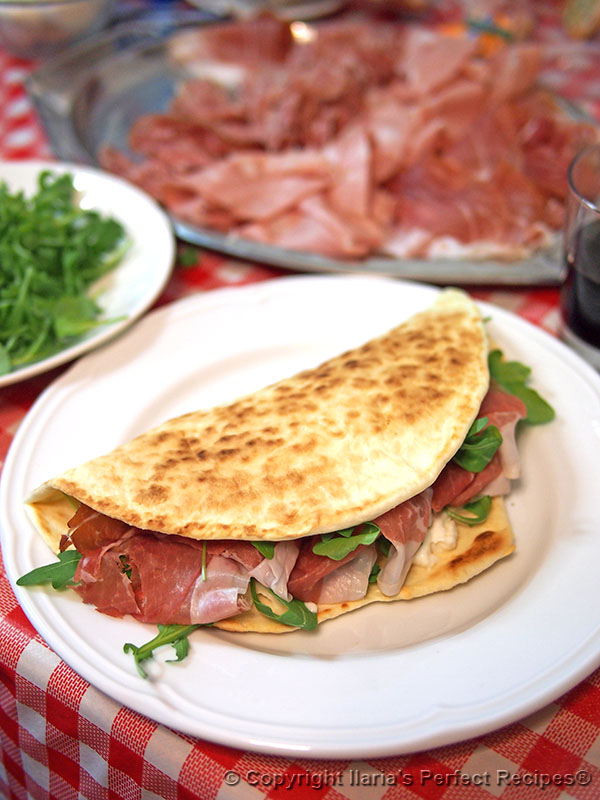
Piadina is no doubt a typical product of the Romagna, a portion of the Emilia-Romagna region (Ravenna, Faenza, Forlì, Cesena and Rimini), but it’s also widespread in the areas of Ferrara, Pesaro e Urbino province, Montefeltro and the Republic of San Marino.
It’s usually made with wheat flour, fats (extra virgin olive oil and/or lard=rendered pork fat), water and/or milk, salt and some optional leavening agents and traditionally cooked on a clay dish from Montetiffi, a village near the town of Forlì, although nowadays flat pans or electric griddles are commonly used but the flavour would be less aromatic (video of the making of Montetiffi pan here or international online shop here).
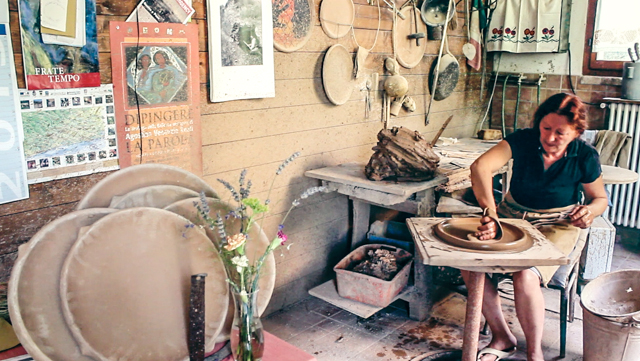
Creation of the Montetiffi pan. Old traditions handed down from father to son.
“Prema u s’fa e’ pianèl, pu dop u s’fa l’arvel pu dop u s’fa l’avrecia… ech fat la tégia!”. (Romagna dialect)
(tr.: EN. “First you create the flat base, then you make the border and then the indentation… that’s the pan!” – IT. “Prima si fa il piano, dopo si fa il bordo e poi l’orecchia… ecco fatta la teglia!”).
Once cooked, these delicacies are usually stuffed with either sweet or salted and savoury ingredients such as cured meats (salumi), cheeses, greens, or Nutella cream, but one of the most popular and best-selling combination is Parma ham + Squacquerone (a fresh and soft spreadable cow’s milk cheese with a typical tart flavour) + arugula/rocket, mmmm yummy!
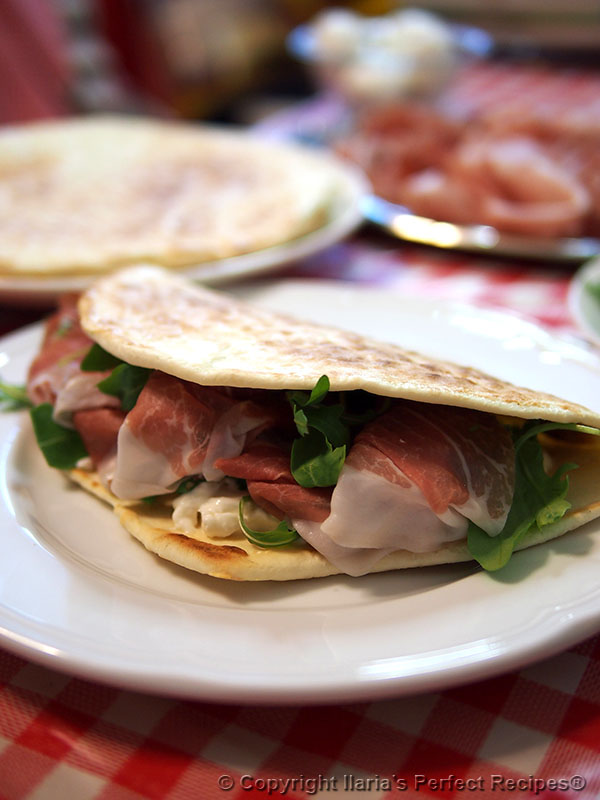
Wow it makes me hungry every time I think about it! Not to mention the classic “winterly” stuffing with sausage and roasted/caramelized onions… 8).
History
Up to 100 years ago, Piadina was a poor man’s food because was considered to be a bread substitute to which people resorted weekly between a batch of bread and the other (bread was usually cooked once a week) but during the 60s women from the countryside started to prepare and sell it on the roads of the town with a hand-cart and a beach umbrella, therefore Piadina became a real meal.
Nowadays you can find Piadina in food stands all along the Romagna coast or Romagna towns.
Pay attention that those store-brought Piadinas that you can find in supermarkets are nothing like those you can make at home or find in Romagna!
So, have you ever had the fortune to bite into a rich, crispy but soft steaming piadina filled with every kind of delicacies??? If not, well, find some time to make that at home, it’s easy! or visit Romagna and let me know if you like it!
“Delicious with every filling, “La j’è bona in tot i mud,delicious even served plain: la j’è bona énca scundida:if you haven’t already understood, sà n’avì ancora capì,I’m talking about piadina.” a scor propri dla pida.”(Folk poetry)
Here I’m writing several Piadina recipes along with my favourite one because I always heard or read strong and intense discussions around the “real” or the “perfect” recipe for Piadina but the perfect recipe for Piadina does not exist.
As I’ve already explained you before, every family has their recipe so the real recipe is that one that you’ve eaten in your lifetime, the one that makes you connect to your relatives or friends.
So, in order to make you choose the right one for you, I want to explain better the differences to whom that less know the local traditions.
THE SHAPE
Starting from the south of Romagna coast Piadina is very thin (up to 3mm-1/8in) and with a large diameter (from 23cm-9in to 30cm-12in) while proceeding north along the coast and to the inside towards the hills, the flatbread become thicker (from 4mm-1/6in to 8mm-5/16in) and smaller (from 15cm-6in to 25cm-10in).
THE INGREDIENTS IN THE DOUGH
The fats: people use extra virgin olive oil for a lighter and crispier piadina or lard from rendered pork fat (called “strutto” in italian) for a more rich and soft piadina or they use a combinations of both.
The liquids: people use water or whole milk or a combination of both.
Other optional ingredients: some people use baking soda or baking powder to make the dough rise a bit or more while cooking.
If you want a crispier Piadina, choose the one without lard and no leavening agents.
I like the Piadina to be a bit thick, soft, easy to fold without cracking with a great buttery richness, so I use lard instead of olive oil, a mix between water and milk and baking powder to make it less heavy.
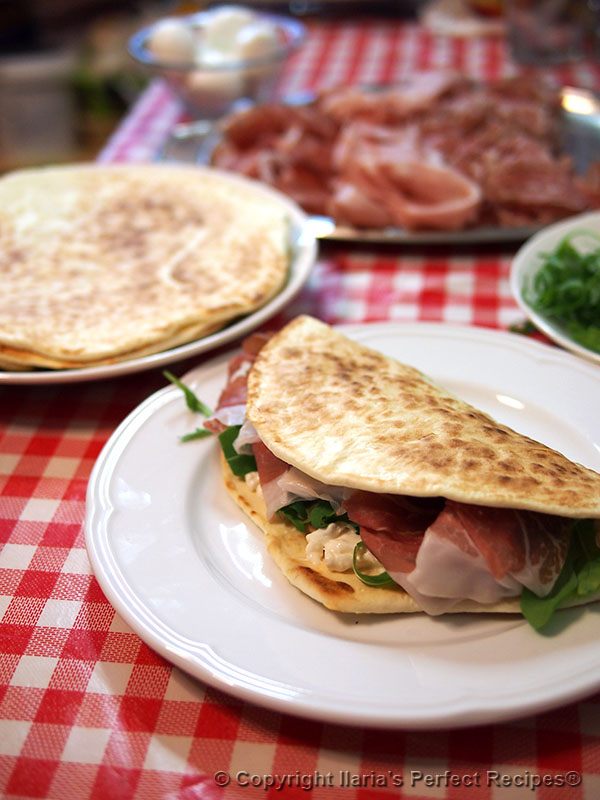
Piadina Romagnola authentic italian recipe
![]() Difficulty: easy
Difficulty: easy
![]() Preparation: 40 minutes
Preparation: 40 minutes ![]() Cooking Time: 15 minutes
Cooking Time: 15 minutes
![]() Yield: 5-6 servings
Yield: 5-6 servings
Ingredients for my favourite Piadina dough (a bit thick, soft, easy to fold without cracking with a great rich and buttery taste):
- 500 grams / 18 ounces / 4 cups all-purpose flour
- 75 grams / 2.70 ounces lard from rendered pork fat (called “strutto” in italian)
- 8 grams / 2 tsp baking powder
- 8 grams / 1 full tsp salt
- 150ml / 3/4 cup / 5.00 Us fluid ounces whole milk
- ≈ or a bit less than 100ml / 1/2 cup / 3.40 Us fluid ounces water
- 500 grams / 18 ounces / 4 cups all-purpose flour
- 50 grams / 1.80 ounces / 4 tbsp extra virgin olive oil
OR
75 grams / 2.70 ounces lard from rendered pork fat (called “strutto” in italian)
OR
a mix between them - 8 grams / 2 tsp baking powder
OR
1 tsp of baking soda
OR
no leavening agents - 8 grams / 1 full tsp salt
- 250 ml / 1 1/4 cups / 8.5 Us fluid ounces of liquids (whole milk, water or both)
Combine lard (if used), flour and salt, then mix in water and/or milk, olive oil (if used), baking powder or baking soda (if used).
Knead the dough for about 10 minutes until quite smooth, uniform, soft but no sticky (if it’s sticky add more flour).
Make a ball and cover the dough with plastic wrap and let rest at least 30 minutes at room temperature (if the dough is being prepared more than 1 hour in advance, you can keep it in the fridge and when needed remove 1 hour before using it).
Heat Montetiffi pan or a non-stick pan over medium-high heat if you’re eating piadina immediately.
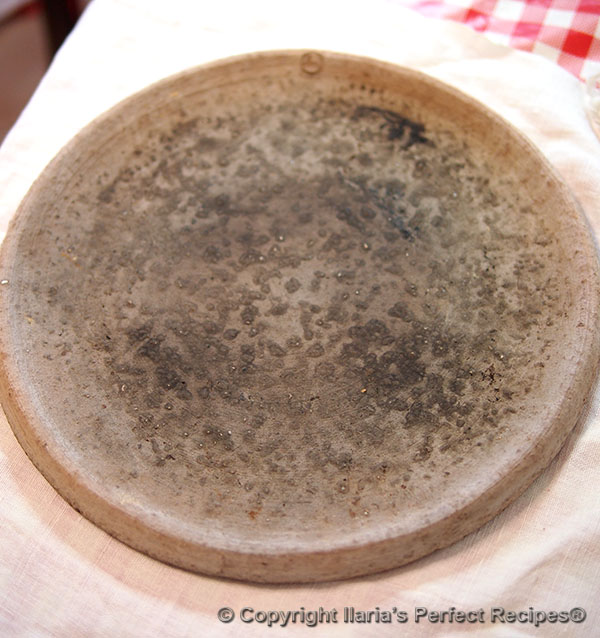
My used Montetiffi pan. Brown spots after using it are normal and they don’t affect the cooking process.
Divide the ball into several pieces (I suggest 5 – about 140-150gr each ball).
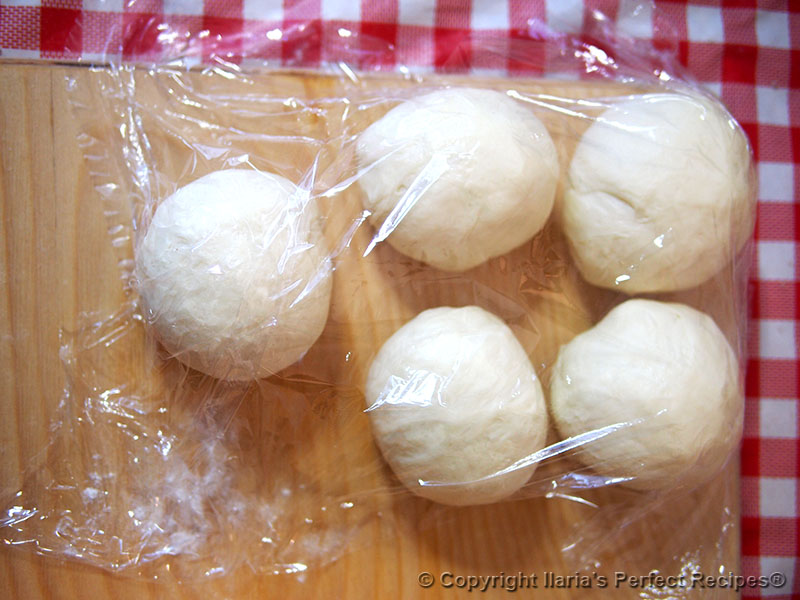
Roll out the dough into a circle with a rolling pin on a floured surface to the desired thickness (I like it thicker, 4mm-1/6in).
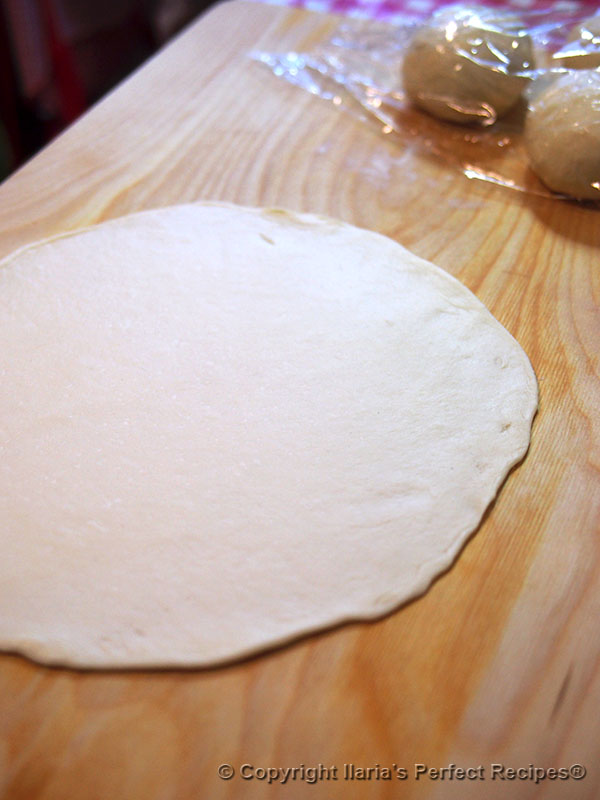
If you want the circle to be perfect, use a round cutter large enough.
As you can see I don’t mind! (so people know that are home made)
If you’re making large quantities of this recipe or want to rolled out piadina few hours in advance, I suggest you to stack up the rolled out dough by putting a baking paper sheet between each piadina until you’re ready to cook.
Once the pan is hot, add raw piadina, prick it all over with a fork to avoid air bubbles and cook for about 1-2 minutes for a thin piadina, 2-3 minutes for a thicker one or however until forming brown spots onto the bottom.
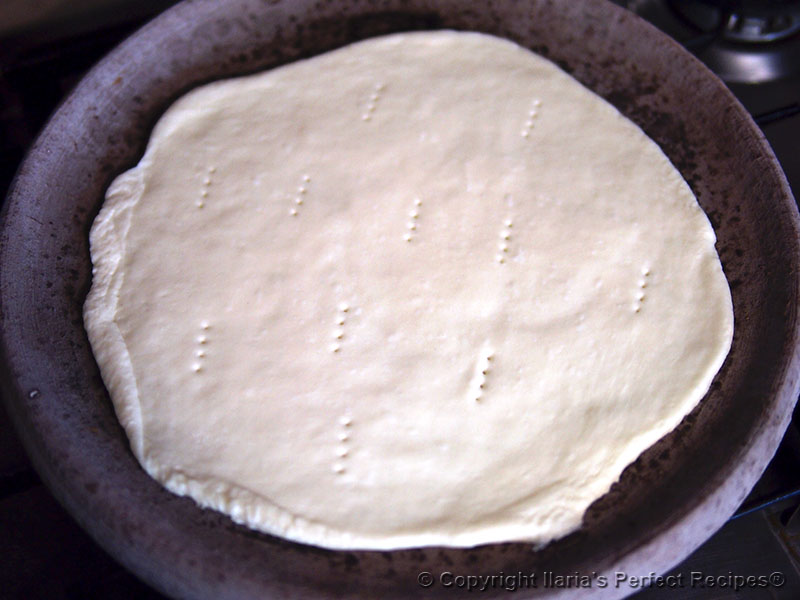
Then flip and cook for about the same time.
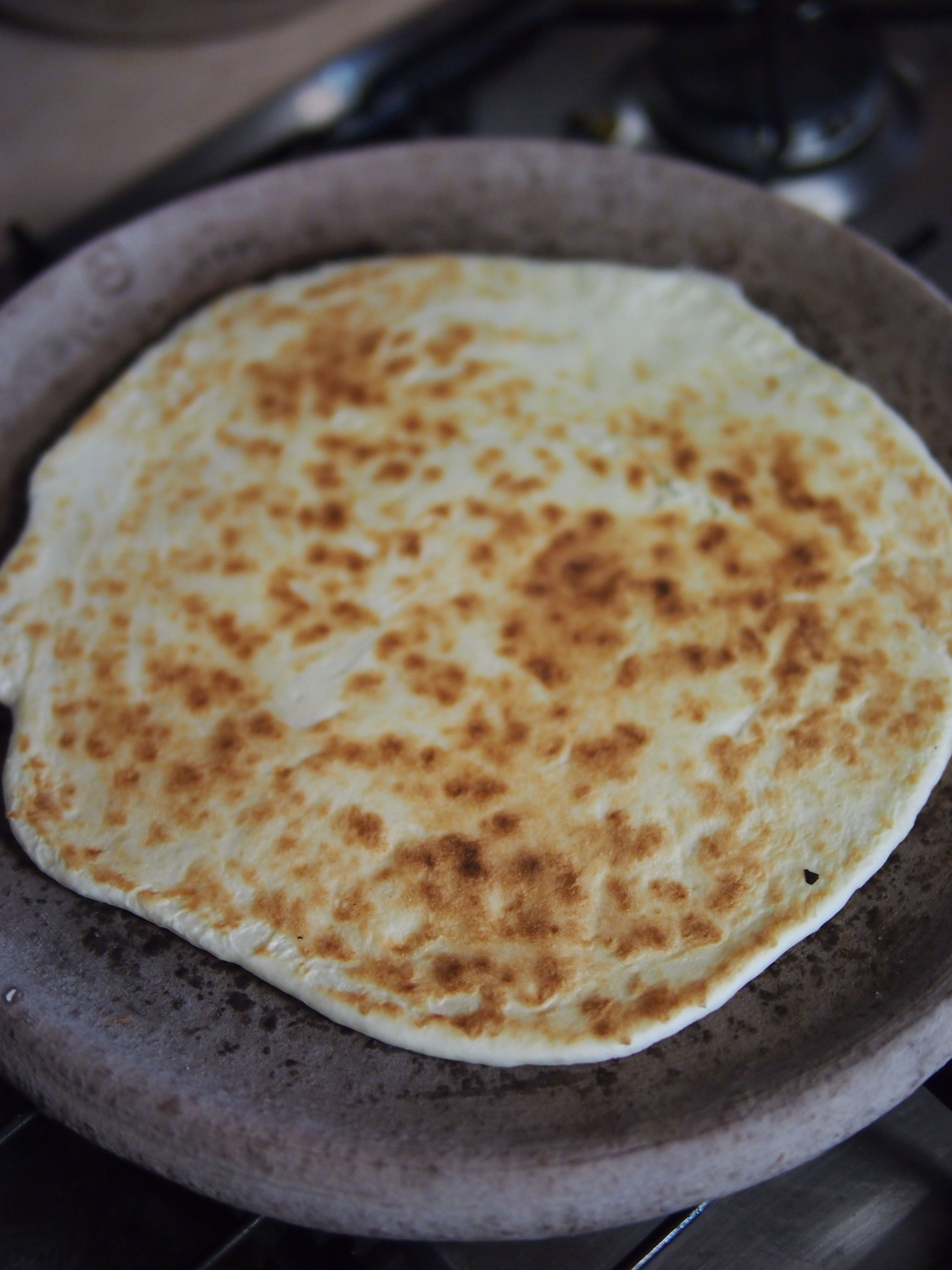
Remember that piadina should be served hot, so it’s recommended to have your fillings ready.
Once cooked you can serve piadina immediately by placing your desired filling on a half and then close to a half moon or cutting it as is into triangles to use as a bread-substitute.
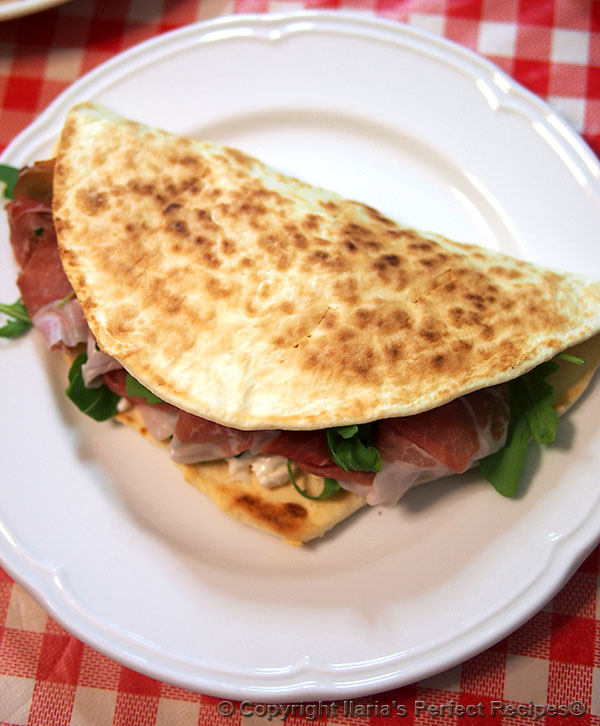
If you don’t serve piadinas right away, you can stack them up, put into a well-sealed plastic bag, and put in the fridge for about a week or in the freezer for a couple of months and when you want a quick meal just put cold or frozen piadina onto a pan until it’s hot enough (do not over cook).
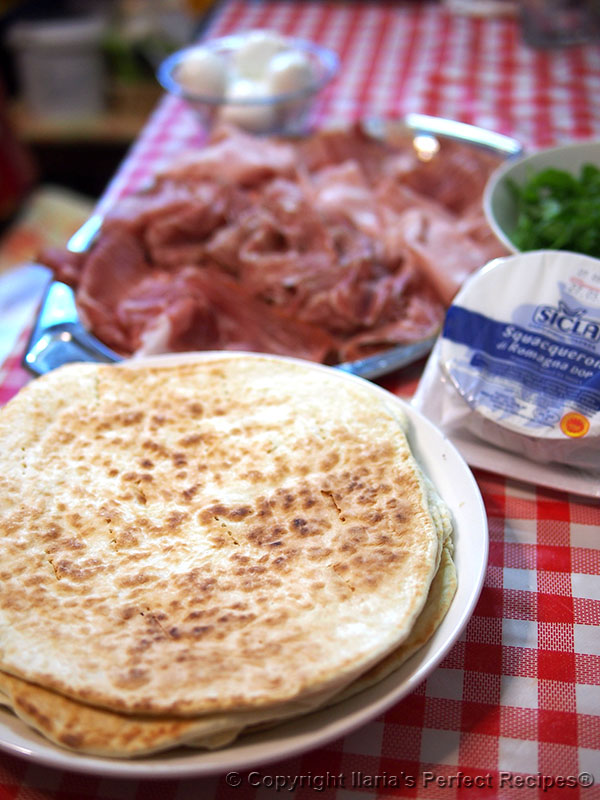
Here I give you some ideas of ingredients to put in your piadina:
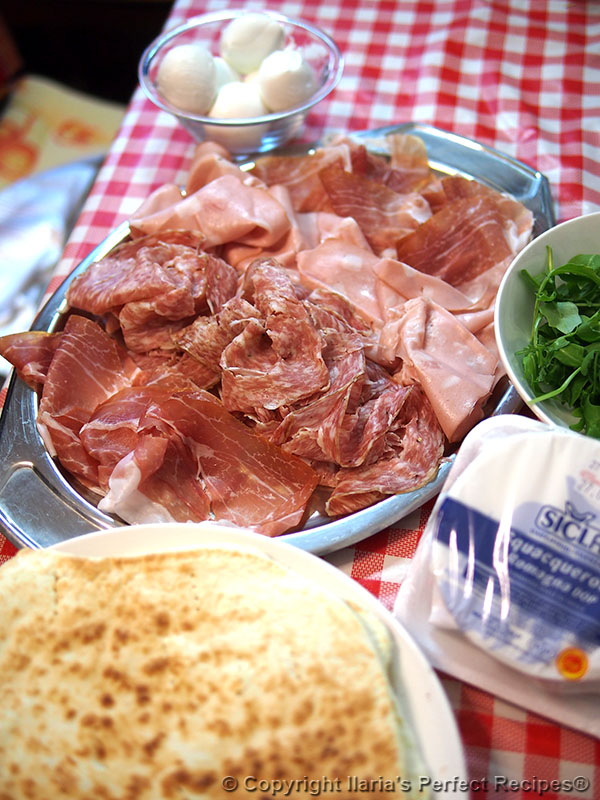
The savoury:
- Parma ham or other cured meats (salami), soft cheese (the original squacquerone or cream cheese, or ricotta) and arugula/rocket;
- roasted/caramelized onions and sausage;
- cooked ham, fontina or taleggio or asiago cheese and mushrooms mayonnaise;
- porchetta with onions;
- smoked cheese and ham;
- bell peppers and sausage;
- cooked ham, mozzarella, mushrooms;
- Parma ham, mozzarella and tomatoes;
- mortadella (not baloney of course);
- wurst and mustard (hot dog style);
- sausage, pepperoni, onion and hot sauce;
- sausage, onion, bell peppers and beans;
- bacon cooked with balsamic vinegar and radicchio;
- squash/pumpkin, sausage and mozzarella;
(sorry for the amount of pork meat choices but I was born and live in Emilia-Romagna region and as for every real Emiliano, we cannot live without pork meat, we will be seriously ill! :D)
- roast-beef, mayonnaise, lettuce and tomato;
- roast-beef, arugula/rocket and shredded Parmigiano Reggiano cheese;
- roast-beef and roasted potatoes;
- roasted potatoes and smoked cheese;
- good quality canned tuna, mozzarella, tomatoes, oregano and mayonnaise;
- mozzarella and grilled vegetables;
- smoked salmon, dill and mayonaise or sour cream;
- smoked salmon and cream cheese;
- tomatoes, aurugula/rocket, mushrooms and shredded Parmigiano Reggiano cheese;
- roasted/caramelized onions and gorgonzola cheese (or blu cheese);
- sliced turkey breast, fontina or taleggio or asiago cheese and mushrooms mayonnaise.
Or the sweets:
- Nutella or Nutella and mascarpone or Nutella and banana;
- fruit jam or ricotta and fruit jam;
- honey and cheeses;
- white chocholate and shredded coconut.
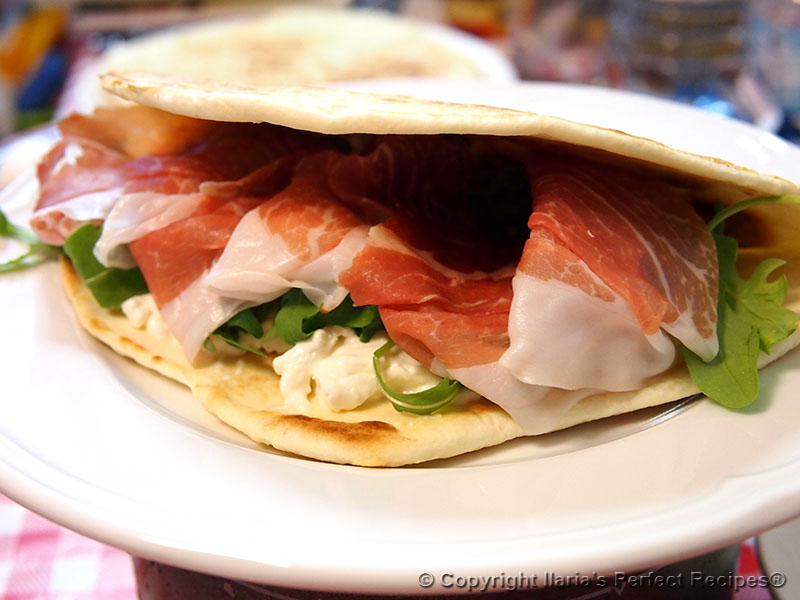
So what’s your favourite recipe for piadina? The crispy, the soft, the thin or the thick? And what stuffing would you like to put in there?
As you can see, Piadina is a very simple recipe, tastier than other flatbreads, and you can fill it with a lot of ingredients to make it as a real meal. So that’s why piadina has earned its place in the gastronomic hall of fame, becoming one of the most loved and enjoyable italian foods.
- 500 grams / 18 ounces / 4 cups all-purpose flour
- 75 grams / 2.70 ounces lard from rendered pork fat (called "strutto" in italian)
- 8 grams / 2 tsp baking powder
- 8 grams / 1 full tsp salt
- 150ml / ¾ cup / 5.00 Us fluid ounces whole milk
- ≈ or a bit less than 100ml / ½ cup / 3.40 Us fluid ounces water
- 500 grams / 18 ounces / 4 cups all-purpose flour
- 50 grams / 1.80 ounces / 4 tbsp extra virgin olive oil
- OR
- 75 grams / 2.70 ounces lard from rendered pork fat (called "strutto" in italian)
- OR
- a mix between them
- 8 grams / 2 tsp baking powder
- OR
- 1 tsp of baking soda
- OR
- no leavening agents
- 8 grams / 1 full tsp salt
- 250 ml / 1¼ cups / 8.5 Us fluid ounces of liquids (whole milk, water or both)
- Combine lard (if used), flour and salt, then mix in water and/or milk, olive oil (if used), baking powder or baking soda (if used).
- Knead the dough for about 10 minutes until quite smooth, uniform, soft but no sticky (if it's sticky add more flour).
- Make a ball and cover the dough with plastic wrap and let rest at least 30 minutes at room temperature (if the dough is being prepared more than 1 hour in advance, you can keep it in the fridge and when needed remove 1 hour before using it).
- Heat Montetiffi pan or a non-stick pan over medium-high heat if you're eating piadina immediately.
- Divide the ball into several pieces (I suggest 5 - about 140-150gr each ball).
- Roll out the dough into a circle with a rolling pin on a floured surface to the desired thickness (I like it thicker, 4mm-1/6in).
- If you want the circle to be perfect, use a round cutter large enough.
- Once the pan is hot, add raw piadina, prick it all over with a fork to avoid air bubbles and cook for about 1-2 minutes for a thin piadina, 2-3 minutes for a thicker one or however until forming brown spots onto the bottom.
- Then flip and cook for about the same time.
- Remember that piadina should be served hot, so it's recommended to have your fillings ready.
- Once cooked you can serve piadina immediately by placing your desired filling on a half and then close to a half moon or cutting it as is into triangles to use as a bread-substitute.

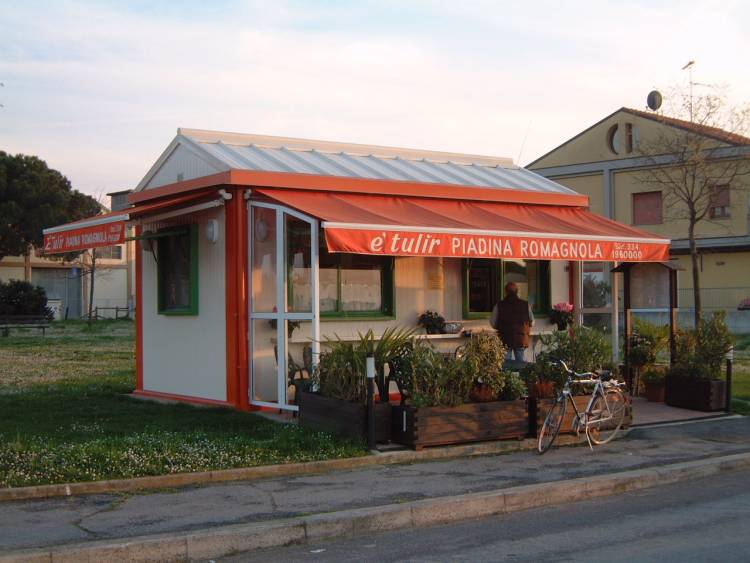

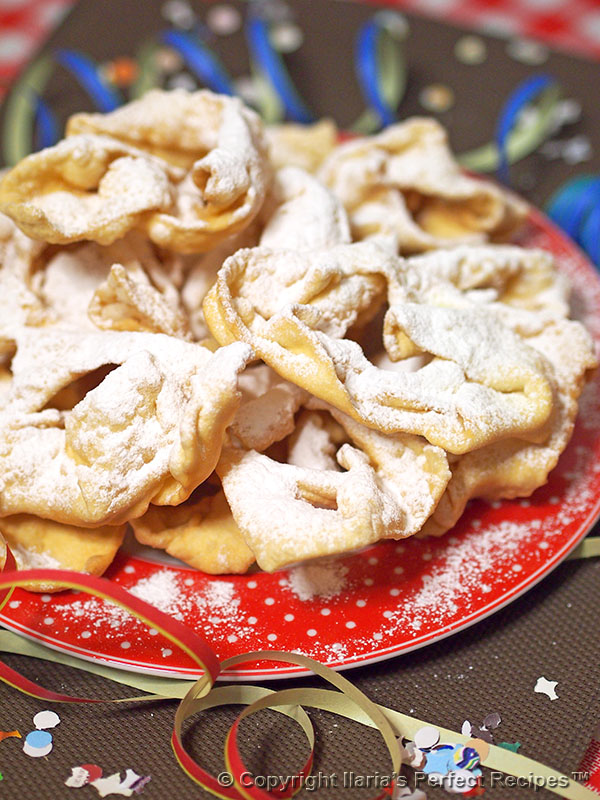
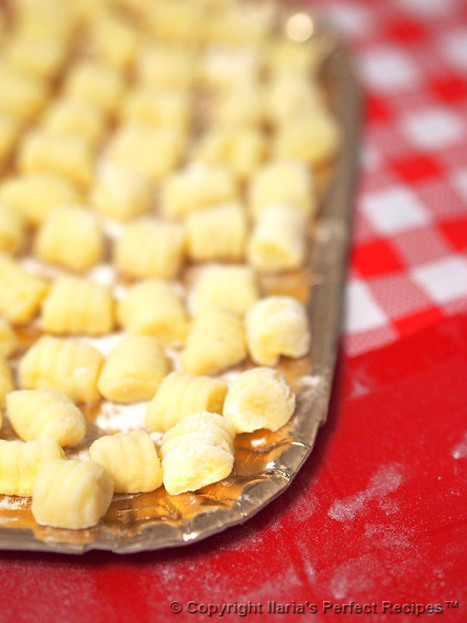
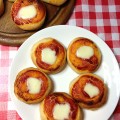
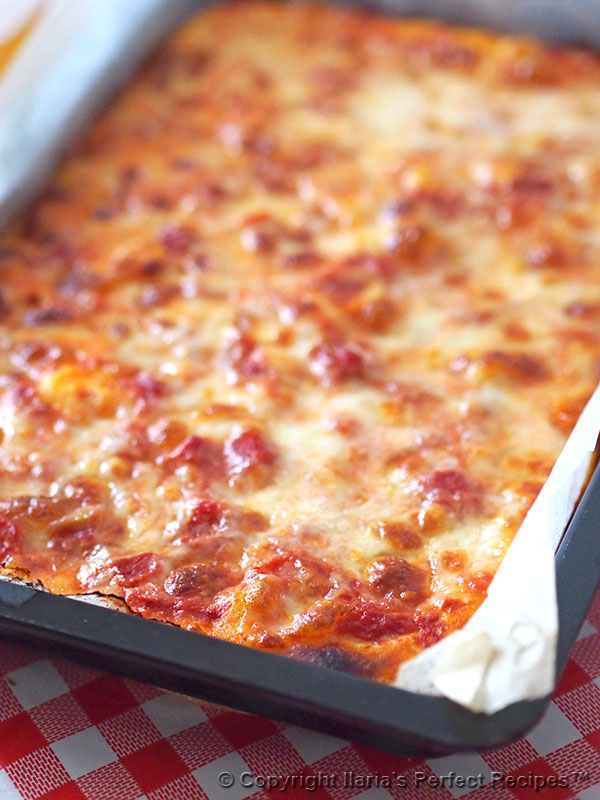
Where can I buy one of the Monteffi pans?
Hello Gina, just above the photo of the lady who creates the Montetiffi Pan there’s the link to the shop.
Just got back from a night shift and had to make one of these immediately. Now munching on a piadina with Parma ham, mozzarella and tomato. Delicious.
Always comforting…. especially after a night shift! Thanks for stopping by!
I’ve jsut learned about these fabulous breads on a cookery programme in England (Rick Stein – Venice to Istambul) and love the sound of them. Am going to make them this week, thanks for a great post!
Thank you for stopping by!
Ilaria, I just returned from Italy and really enjoyed the piadinas. I would like to order the montetiffi pan, but I do not understand Italian enough to order online. Can you help me? Grazie!
Sure! Send me an email with your address detail and I can contact the shop about the shipping costs.
I’ve seen there is also a shop on ebay that sells this pan, the name of the seller is marco-mpforniture, maybe in this case is easier for you to contact the seller about the shipping costs.
Either way, I’m glad to help.
My e-mail address is Grace@Synergy-Packaging.com
Is it possible you can also recommend where I can buy some Squacquerone cheese and great salami? Mmmm . . . my mouth is watering for a piadina! Thank you so very much for your quick reply and help . . . Grazie!
Ciao a beautiful read, grazie…my family is from Piacenza and now I have a craving for piadina so now I must make some!!!!
Ciao Samantha! Yes you should! It’s so easy to make and sooo easy to eat ahah!
Thanks for passing by!
If piadine are eaten with the sweet fillings, is it considered to be a breakfast food? I know sweet foods and pastries are eaten at breakfast time in Italy.
I learned how to make piadine at a cooking class in Bologna and will have a go at making them at home soon 🙂
Hi Anne,
nowadays piadina with sweet fillings is almost used as a dessert or as an afternoon break.
Maybe our grandparents used to eat it also at breakfast, with jam, because they didn’t have nothing else to eat.
BTW nothing prevents you from eating it at breakfast!
Can I use butter instead of lard or is it nit going to work?
Yes Alex, you can use butter if you want! The taste would be “buttery” 😉 Try to use a good quality one. Bye!
This recipe is perfect, thank you for sharing
Thanks to you and for stopping by!